A systematic investigation of the differential roles for ventral tegmentum serotonin 1- and 2-type receptors on food intake in the rat
- PMID: 27431937
- PMCID: PMC5018453
- DOI: 10.1016/j.brainres.2016.07.016
A systematic investigation of the differential roles for ventral tegmentum serotonin 1- and 2-type receptors on food intake in the rat
Abstract
Central serotonin (5-HT) pathways are known to influence feeding and other ingestive behaviors. Although the ventral tegmentum is important for promoting the seeking and consumption of food and drugs of abuse, the roles of 5-HT receptor subtypes in this region on food intake have yet to be comprehensively examined. In these experiments, food restricted rats were given 2-h access to rat chow; separate groups of non-restricted animals had similar access to a sweetened fat diet. Feeding and locomotor activity were monitored following ventral tegmentum stimulation or blockade of 5-HT1A, 5-HT1B, 5-HT2A, 5-HT2B, or 5-HT2C receptors. 5-HT1A receptor stimulation transiently inhibited rearing behavior and chow intake in food-restricted rats, and had a biphasic effect on non-restricted rats offered the palatable diet. 5-HT1B receptor agonism transiently inhibited feeding in restricted animals, but did not affect intake of non-restricted rats. In contrast, 5-HT1B receptor antagonism decreased palatable feeding. Although stimulation of ventral tegmental 5-HT2B receptors with BW723C86 did not affect hunger-driven food intake, it significantly affected palatable feeding, with a trend for an increasing intake at 2.0µg/side but not at 5.0µg/side. Antagonism of the same receptor modestly but significantly inhibited feeding of the palatable diet at 5.0µg/side ketanserin. Neither stimulation nor blockade of 5-HT2A or 5-HT2C receptors caused prolonged effects on intake or locomotion. These data suggest that serotonin's effects on feeding within the ventral tegmentum depend upon the specific receptor targeted, as well as whether intake is motivated by food restriction or the palatable nature of the offered diet.
Keywords: Feeding; Motivation; Reward; Serotonin; Ventral tegmental area.
Copyright © 2016 Elsevier B.V. All rights reserved.
Figures
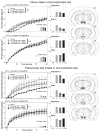
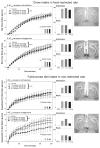
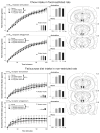
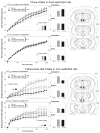
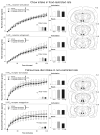
Similar articles
-
Contrasting effects of 5-HT3 receptor stimulation of the nucleus accumbens or ventral tegmentum on food intake in the rat.Behav Brain Res. 2017 Apr 14;323:15-23. doi: 10.1016/j.bbr.2017.01.031. Epub 2017 Jan 20. Behav Brain Res. 2017. PMID: 28115218 Free PMC article.
-
Selective serotonin receptor stimulation of the ventral tegmentum differentially affects appetitive motivation for sugar on a progressive ratio schedule of reinforcement.Behav Brain Res. 2021 Apr 9;403:113139. doi: 10.1016/j.bbr.2021.113139. Epub 2021 Jan 23. Behav Brain Res. 2021. PMID: 33497748 Free PMC article.
-
Serotonin 1A, 1B, and 7 receptors of the rat medial nucleus accumbens differentially regulate feeding, water intake, and locomotor activity.Pharmacol Biochem Behav. 2013 Nov;112:96-103. doi: 10.1016/j.pbb.2013.10.002. Epub 2013 Oct 11. Pharmacol Biochem Behav. 2013. PMID: 24125784 Free PMC article.
-
Serotonin conflict in sleep-feeding.Vitam Horm. 2012;89:223-39. doi: 10.1016/B978-0-12-394623-2.00012-3. Vitam Horm. 2012. PMID: 22640616 Review.
-
Studies on the neuroendocrine role of serotonin.Dan Med Bull. 2007 Nov;54(4):266-88. Dan Med Bull. 2007. PMID: 18208678 Review.
Cited by
-
How Can Animal Models Inform the Understanding of Cognitive Inflexibility in Patients with Anorexia Nervosa?J Clin Med. 2022 May 5;11(9):2594. doi: 10.3390/jcm11092594. J Clin Med. 2022. PMID: 35566718 Free PMC article. Review.
-
Contrasting effects of 5-HT3 receptor stimulation of the nucleus accumbens or ventral tegmentum on food intake in the rat.Behav Brain Res. 2017 Apr 14;323:15-23. doi: 10.1016/j.bbr.2017.01.031. Epub 2017 Jan 20. Behav Brain Res. 2017. PMID: 28115218 Free PMC article.
-
Mirtazapine and ketanserin alter preference for gambling-like schedules of reinforcement in rats.Prog Neuropsychopharmacol Biol Psychiatry. 2017 Jul 3;77:178-184. doi: 10.1016/j.pnpbp.2017.03.027. Epub 2017 Apr 12. Prog Neuropsychopharmacol Biol Psychiatry. 2017. PMID: 28412411 Free PMC article.
-
Ginkgo biloba Extract (GbE) Stimulates the Hypothalamic Serotonergic System and Attenuates Obesity in Ovariectomized Rats.Front Pharmacol. 2017 Sep 5;8:605. doi: 10.3389/fphar.2017.00605. eCollection 2017. Front Pharmacol. 2017. PMID: 28928661 Free PMC article.
-
Brain serotonin, oxytocin, and their interaction: Relevance for eating disorders.J Psychopharmacol. 2025 Mar;39(3):187-200. doi: 10.1177/02698811241309617. Epub 2025 Jan 2. J Psychopharmacol. 2025. PMID: 39745000 Free PMC article. Review.
References
-
- Arvidsson LE, Hacksell U, Nilsson JL, Hjorth S, Carlsson A, Lindberg P, Sanchez D, Wikstrom H. 8-Hydroxy-2-(di-n-propylamino)tetralin, a new centrally acting 5-hydroxytryptamine receptor agonist. J Med Chem. 1981;24:921–923. - PubMed
-
- Aulakh CS, Hill JL, Yoney HT, Murphy DL. Evidence for involvement of 5-HT1C and 5-HT2 receptors in the food intake suppressant effects of 1-(2,5-dimethoxy-4-iodophenyl)-2-aminopropane (DOI) Psychopharmacology (Berl) 1992;109:444–448. - PubMed
-
- Baldwin BA, de la Riva C. Effects of the 5-HT1A agonist 8-OH-DPAT on operant feeding in pigs. Physiol Behav. 1995;58:611–613. - PubMed
Publication types
MeSH terms
Substances
Grants and funding
LinkOut - more resources
Full Text Sources
Other Literature Sources

